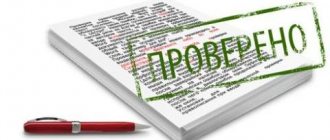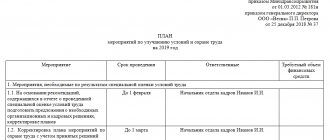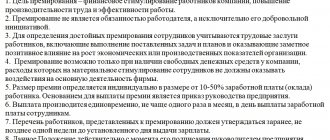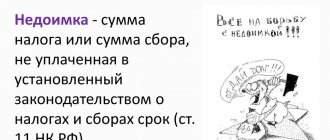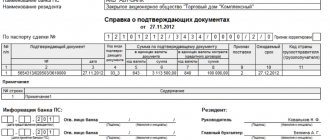Conditions for additional measures
In order for the tax authority to have the opportunity to carry out additional measures, its head must establish:
- Has the taxpayer under audit committed (or failed to commit) a violation of the law;
- Violations identified during the inspection constitute an offense or not.
All tax control activities should be aimed only at collecting additional evidence regarding identified violations, but not at identifying new ones. That is, if tax authorities require evidence that is not related to the violations reflected in the audit report, this is a violation of the interests of the organization - the taxpayer.
Federal Tax Service of Russia: Nuances of carrying out additional tax control measures
The decision to carry out additional tax control measures can be made no earlier than the following procedures are completed:
- completion of the tax audit;
- drawing up and delivering a tax audit report;
- consideration of tax audit materials by the head (deputy head) of the tax authority.
This is stated in the letter of the Federal Tax Service of the Russian Federation dated October 19, 2021 No. ED-4-2/ [email protected] “On consideration of the appeal . Let us remind you that an addition to the act is drawn up if the tax authorities carried out additional tax control measures in relation to the declaration, the audit of which was completed after September 3.
The Federal Tax Service noted that the addition to the tax audit report cannot indicate violations of tax legislation that were not previously reflected in the tax audit report. That is, these tax control measures can only be aimed at collecting additional evidence that relates to offenses identified during the audit, but not at identifying new violations.
Letter of the Federal Tax Service of Russia dated October 19, 2021 No. ED-4-2/ [email protected] 11/08/2018 The Federal Tax Service, having considered the Internet appeal, reports the following.
1. The provisions of paragraphs 6.1 and 6.2 of Article 101 of the Tax Code of the Russian Federation (as amended by Federal Law No. 302-FZ dated August 3, 2018 “On Amendments to Parts One and Two of the Tax Code of the Russian Federation”) are applied when making decisions based on the results of tax audits, completed after the date of entry into force of the specified federal law, that is, after September 3, 2018.
In this case, the decision to carry out additional tax control measures may be made no earlier than the completion of the procedures: completion of the tax audit, drawing up and delivery of the tax audit report, consideration of the tax audit materials by the head (deputy head) of the tax authority.
2-3. Additional tax control measures in accordance with paragraph 6 of Article 101 of the Tax Code of the Russian Federation (hereinafter referred to as the Code) are prescribed if it is necessary to obtain additional evidence in order to confirm the fact of violations of the legislation on taxes and fees or the absence thereof. In this case, these activities can only be carried out to verify already established violations.
This conclusion follows from the legal position of the Constitutional Court of the Russian Federation, set out in Resolution No. 9-P of July 14, 2005, which notes that the purpose of additional tax control measures is to clarify the circumstances related to detected tax offenses.
In addition, the Plenum of the Supreme Arbitration Court of the Russian Federation in its Resolution No. 57 of July 30, 2013 “On some issues arising when arbitration courts apply part one of the Tax Code of the Russian Federation” (hereinafter referred to as the Resolution of the Plenum of the Supreme Arbitration Court of the Russian Federation No. 57) in paragraph 39 indicated, that when assessing the legality of a decision to prosecute for committing a tax offense or a decision to refuse to prosecute for committing a tax offense, adopted by a tax authority on the basis of Article 101 of the Code, the courts should proceed from the fact that those appointed by the head (deputy head) of the tax authority Additional tax control measures can only be aimed at collecting additional evidence related to the offenses identified during the audit, but not at identifying new offenses.
According to clause 6.1 of Article 101 of the Code, the addition to the tax audit report shall indicate the additional evidence received to confirm the fact of violations of the legislation on taxes and fees or the absence thereof. In this case, we are talking about facts of violations of the legislation on taxes and fees, which are reflected in the tax audit report.
Taking into account the above, the tax authority does not have the right to indicate in the addendum to the tax audit report violations of the legislation on taxes and fees that were not previously reflected in the tax audit report.
According to paragraph 44 of the Resolution of the Plenum of the Supreme Arbitration Court of the Russian Federation No. 57, after a decision has been made to prosecute for committing a tax offense or a decision to refuse to prosecute for committing a tax offense, the head (deputy head) of the tax authority does not have the right to make changes to this decision that worsen the position of the person , in respect of which such a decision was made, with the exception of the correction of clerical errors, typos and arithmetic errors.
At the same time, it is recognized as permissible for the tax authority to make changes to these decisions, as well as their complete cancellation, if this entails an improvement in the situation of the taxpayer.
This legal position is also applicable in a situation where there is a need to correct clerical errors, typos and arithmetic errors made in the tax audit report.
In addition, it should be noted that there are court decisions in which an increase in the amount of additional tax assessments based on the results of additional tax control measures was recognized as legitimate.
So, for example, in the resolution of the Seventeenth Arbitration Court of Appeal dated January 21, 2015 No. 17AP-16501/2014-AK in case No. A50-24007/2013 and the resolution of the Arbitration Court of the Ural District dated April 23, 2015 No. F09-1929/15 in the same case it is indicated that in a situation where the amounts of additional assessments based on the results of additional tax control measures were increased due to the fact that the taxpayer submitted documents with objections to the act that tax authority officials did not have the opportunity to study during an on-site tax audit, while the submitted documents are related Only for those violations that are already reflected in the audit report (identified during the audit), the actions of the tax authority are recognized as lawful, since otherwise this will entail the exemption of the taxpayer from paying tax if the hidden object of taxation is actually revealed.
This position is confirmed by the Ruling of the Supreme Court of the Russian Federation dated August 20, 2015 No. 309-KG15-9617.
This letter does not contain legal norms, does not specify regulatory requirements and is not a regulatory legal act. The letter is of an informational and explanatory nature and does not prevent taxpayers (tax payers, insurance premium payers, tax agents), tax authorities and courts from being guided by the norms of the legislation of the Russian Federation in an understanding that differs from the stated interpretation.
Acting State Councilor
Russian Federation 2nd class
D.V. Egorov
t axpravo.ru
Share link:
- Click here to share content on Facebook. (Opens in a new window)
- Click to share on WhatsApp (Opens in new window)
- Click to share on Telegram (Opens in new window)
- Click to share on Twitter (Opens in new window)
Similar
Registration of the results of additional measures
There is no specific procedure by which tax authorities should send materials on additional measures. The Tax Code also does not provide for a procedure for documenting the results of such events, that is, drawing up any act or certificate.
However, Article 101 of the Tax Code of the Russian Federation provides for the taxpayer’s right to familiarize himself with the materials of both the audit itself and additional measures related to it. In other words, the tax office must ensure the implementation of such a right and do this within two days from the moment the taxpayer submits the relevant application. The familiarization process occurs through visual examination of extracts, copies and other materials on the territory of the tax authorities.
After reviewing the inspection materials, a protocol is drawn up in the form specified in the appendix to Letter No. CA-4-9/ [email protected]
What are additional activities and when are they assigned?
Additional tax control measures are discussed in paragraph 6 of Article 101 of the Tax Code of the Russian Federation. This includes requesting documents, questioning witnesses and conducting an examination . Such measures are appointed by decision of the head of the tax authority or his deputy. The basis for making a decision is the need to obtain additional evidence that would confirm or refute the fact that the taxpayer committed a violation.
The period for carrying out such activities is a month for a regular audit, and 2 months for an audit of a consolidated group of taxpayers.
The aforementioned activities are scheduled before the tax audit is completed and a report is drawn up and handed over to the taxpayer. And also before its materials are reviewed by the management of the Federal Tax Service.
Objection to tax authorities
After additional measures have been taken within ten days, the taxpayer has the right to submit an objection to the tax authorities based on their results. Such an objection is sent in writing and contains comments on all or some of the results. Copies of documents that substantiate the taxpayer’s arguments are attached to the objection.
Such objections are considered by tax authorities before making the main decision on the on-site audit. If the objection contains objective reasons, the tax authorities may postpone consideration of the audit materials (
The essence of the dispute
The tax authority conducted an on-site tax audit. Upon completion of the audit, an act was drawn up, to which the taxpayer submitted objections within the legally established period. The taxpayer was invited to review the tax audit materials, but on the day of their consideration, the tax authority did not make any decision. A few days later, the head of the tax authority appointed additional tax control measures, and a request was sent to the taxpayer to provide documents and explanations. A month later, the tax authority made a decision to hold the taxpayer accountable. At the same time, the taxpayer was not notified of the date of consideration of the results of additional tax control measures and could not provide explanations or objections.
Tax audit decision
Tax authorities review the tax audit report, other materials based on which violations and written objections from the payer were identified during the audit. After this, the tax authorities make a decision either:
- Bring to justice for committing a tax offense;
- Refuse to bring to justice for committing a tax offense.
The tax authorities make a decision within 10 days from the expiration of the deadline for filing objections from the person being inspected. The period for reviewing inspection materials can be extended both before and after pre-events. The time frame for making a decision by tax authorities depends on the fact of their extension and is:
- 10 days is the usual period;
- 1 month – if the tax authorities decided to extend the period for consideration of audit materials and additional measures, based on the results of which the main decision is made;
- 1 month (2 months for a consolidated group) – if the tax authorities decide to carry out additional measures.
Could an additional activity reveal new violations?
No, he can not. The point of additional activities is to find facts confirming already identified offenses . In clause 6.1. Article 101 of the Tax Code of the Russian Federation states that additional evidence should be indicated in the addition to the inspection report. This implies evidence in relation to those offenses that are indicated in the tax audit report itself.
The same conclusion was made in the resolution of the Constitutional Court of July 14, 2005 No. 9-P and the resolution of the Plenum of the Supreme Arbitration Court of July 30, 2013 No. 57. They indicate that additional measures are aimed at collecting evidence on those violations that have already been discovered.
Even if during additional measures some other violations are revealed, inspectors should not include them in addition to the report.
Expected changes in legislation
The only grounds for canceling a decision by a tax official can be violations of the conditions for reviewing tax audit materials, which include:
- failure to provide the taxpayer with the opportunity to take part in the consideration of the case materials, both personally and through his representative;
- failure to provide the taxpayer with the opportunity to provide explanations.
Currently, the State Duma is considering bill No. 249505-7, according to which tax authorities will have to draw up an act based on the results of additional measures. In this case, the taxpayer will have the opportunity to freely familiarize himself with the act and submit his written objections. It is also believed that such a bill will allow tax authorities to make a more objective decision on the results of an audit.
Such an act will have to contain the start date and end date of additional measures and show the essence of the offense. Such a certificate must be handed over to the taxpayer within 5 days from the date of completion of additional measures. Tax authorities will not attach all documents that were submitted by the taxpayer himself to the report. The act must be transferred to the taxpayer against receipt, or in another way, but on the condition that the payer confirms its receipt.
If the taxpayer evades receiving such a report, tax authorities can send it by registered mail to the individual.
In addition to the above, this bill should reduce the time frame for conducting desk audits. Let us remind you that today the term of the “camera chamber” is 3 months. It is proposed to reduce it to one month.
Thus, having come under an on-site inspection by the tax authorities, the taxpayer organization, it is important to control the timing of this procedure. When prescribing additional measures, the person being inspected must provide the required documents and not resist other measures. Due to the fact that the tax office is currently not obliged to provide the audited person with a report on additional measures, the taxpayer must independently express a desire to familiarize himself with the results of additional measures. If the auditee is not satisfied with some aspects of the result of the measures, he can file a tax objection. The main thing is that relevant evidence be attached to this objection.
Order of conduct
Additional tax control measures during an on-site audit and similar control actions during a desk audit are carried out taking into account the requirements of the legislation on control actions by tax authorities and are recorded in the addition to the audit report, taking into account the provisions of clause 6.1. Art. 101 Tax Code of the Russian Federation.
Additional fiscal supervision measures are carried out within a period not exceeding one month from the date of the decision to carry them out (two months for co-consolidated groups and foreign companies). Upon completion of the procedure, within 15 days, an addition to the inspection report is issued containing the following information:
- period of additional control procedures;
- list of completed activities;
- evidence of violation identified or lack thereof;
- conclusions and recommendations based on the results of the audit.
This document is sent within 5 days to the taxpayer, who can, within 15 days after receiving it, submit his objections to the conclusions made by the inspector.
As with a regular inspection, additional control provides for the right of the person being inspected to familiarize himself with the materials of the inspection activities. To do this, a written application is submitted to the Federal Tax Service, and no later than two working days after its submission, the applicant must be familiar with all the documents.
